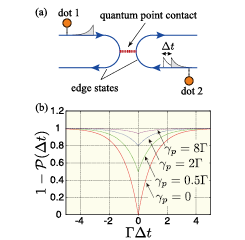Dephasing in Single-Electron Generation Due to Environmental Noise Probed by Hong-Ou-Mandel Interferometry
E. Iyoda, T. Kato, K. Koshino, and T. Martin
Quantum mesoscopic physics, or nanophysics, aims at studying the manifestations of quantum mechanics, such as interference effects and coherence, with electron transport in condensed matter materials. Such manifestations have been studied in the context of quantum optics since the middle of the past century, where fundamental tests of quantum mechanics were explored, for instance, in Hanbury Brown and Twiss [1] (HBT) and Hong-Ou-Mandel [2] (HOM) experiments for photons. The fermionic counterpart of the HOM experiment has been realized quite recently in a setup of a two-electron collider using a quantum point contact (QPC) and two single-electron generators composed of integer quantum Hall edge states and quantum dots [3] (see a schematic figure in Fig. 1(a)). In the fermionic HOM experiment, if two electrons arrive at the QPC simultaneously, the two electrons always scatter into two different output channels because of their fermionic statistics.

Fig. 1 (a) A schematic figure of the Hong-Ou-Mandel-type two-electron collision experiment. Two electrons injected from two quantum dots propagate along edge states of integer quantum Hall states, and collides at a central quantum point contact (QPC). (b) The probability 1-P(Δt), that two electrons scatter into the same edge states, is plotted as a function of a wavepacket delay time Δt. Two electrons always scatter into difference edge states (1-P(Δt) = 0) when Δt = 0 and γp = 0. On the other hand, as the dephasing rate γp increases, the probability 1-P(Δt) at Δt = 0 increases, and approaches the classical value.
In condensed matter settings, the two electrons are always accompanied by the Fermi sea, and as charged particles they interact strongly between themselves and with their environment. The coherence of injected electrons is directly measured by perfectness of anti-correlated scattering in the fermionic HOM experiment. The imperfect anti-correlated scattering reported in [3] includes information about the distinguishability of propagating electrons in the chiral edge channels before arriving at the QPC. At present, the dephasing of propagating electrons has been discussed mostly by considering Coulomb interactions between electrons. The origin of electron decoherence has, however, not yet been determined experimentally. We have examined the effect of electron decoherence by focusing on the role of the energy-level fluctuations of the quantum dot due to this environment [4].
We have employed a simple analytic framework for evaluating the current noises reflecting electron indistinguishability based on the so-called input-output relation, which is a standard theoretical tool in quantum optics. In this approach, the dephasing rate γp due to energy-level fluctuations is easily taken into account in the model Hamiltonian. In order to clarify coherence of generated electrons, we have calculated P(Δt) = Tr(ρ(t)ρ(t+Δt)), where ρ(t) is a density matrix of injected electrons and Δt is the time delay between the two emitted electron wave packets (see Fig. 1(a)), and have obtained an analytic solution, P(Δt) = 1/(1+ γp/Γ) exp(-Γ|Δt|) where Γ is the decay time of electron generators. Figure 1(b) shows a plot of 1-P(Δt), which is proportional to the excess current noise measured at one of the output channels, assuming a balanced transmissivity of QPC. If there is no dephasing (γp = 0), the excess noise is completely suppressed for the simultaneous collision (Δt = 0) between injected electrons. This is the manifestation of the Fermi statistics of the injected electrons. As the pure dephasing rate γp increases, the dip of the current noise is reduced and vanishes for γp >> Γ. We note that P = P(0) corresponds to the purity P = Tr(ρ2) of injected electrons, which has the simple form in our case: P = Γ/(Γ+ γp). The purity approaches 1 for γp << Γ, leading to a perfect suppression of the excess noise.
In our work [4], we have also shown that the time filtering technique helps to enhance the purity, and that a generalization of the present results to an asymmetric setup is possible, with possible implication for measuring the energy detuning of the two injectors in actual experiments. Our calculation provides a useful and comprehensive picture of dephasing effects on the quality of generated single electrons as well as compact formulas for the purity and the current noises in the HOM experiment.
References
References
- [1] R. H. Brown and R. Q. Twiss, Proc. R. Soc. A 242, 300 (1957).
- [2] C. K. Hong, Z. Y. Ou, and L. Mandel, Phys. Rev. Lett. 59, 2044 (1987).
- [3] E. Bocquillon et al., Science 339, 1054 (2013).
- [4] E. Iyoda, T. Kato, K. Koshino, and T. Martin, Phys. Rev. B 89, 205318 (2014).
